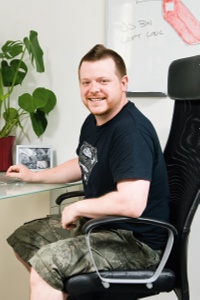Remy Sharp on learning by breaking stuff
Developer, HTML5 Doctor, author and educator Remy Sharp chats to Tanya Combrinck about how he founded Left Logic, why teaching is so important to him and what he has planned for the next five years
This article first appeared in issue 233 of .net magazine – the world's best-selling magazine for web designers and developers.
This article first appeared in issue 233 of .net magazine – the world's best-selling magazine for web designers and developers.
Like many successful coders, Remy Sharp got his first taste as a youngster. “One of my earliest memories is sitting down as a six year old with one of those magazine listings with reams of code, and spending all day typing it out then hitting run and it not working. That’s my earliest memory of hating computers.”
He studied computer information systems design at university, and soon found a way to stand out from his peers. “The course was a mixture of business, psychology and computing. One of our lecturers gave us some Java code and I turned it into an animation of a dancing man. That impressed him and he recommended me to a tiny startup for my industrial placement. It was run by one very smart guy who really knew how to run a business, and how to work me as an individual. I was very much thrown in at the deep end; there was so much going on and I just had to cobble a load of stuff together. Most of my code over the last 15 years has been a case of ‘just stick it together and see if it works’. It tends to work.”
At the end of 2000 Sharp was supposed to go back to university, but stayed at the company for the next nine and a half years, working his way up the ranks until the company was sold to a larger institution and he left to start his own venture.
The only way you learn is by doing it and failing, breaking it and seeing how it goes back together
Sharp tells us he never thought of himself as particularly academically talented. “My skills lie in problem solving and common sense. I understand problems very well, and that’s what made me stand out at that company. That and the fact that when I get excited about something I really want to make it work and I keep at it until it does. I have a very good memory for code, and of course the stuff you’re good at is easy for you, so I sometimes forget it’s hard for others. One of my aims is to teach people the skill of breaking problems down and seeing the solution.”
Getting hands-on
“There are two aspects to learning to code: learning what’s technically possible, and then there’s the soft skill of knowing how to approach a problem. The technical stuff is easy, the hard part is that softer skill, but I do think it’s something that can be taught. You learn by doing it over and over, and getting it wrong quite often. My workshops aren’t academic in style, they’re very hands-on – practical rather than theory. I present a problem and get people to work on solving it.”

Given his teaching style, we wonder if he thinks that an academic setting is the right place to learn to code. What about the current drive to get coding into schools? “The problem is that it takes such a long time to create a curriculum that the technology has moved on by the time it’s delivered. My gut says it’s the fringe initiatives, the code clubs and coding dojos run by people like me that are going to make the difference.”
To someone starting out, he says: “Play, break stuff, experiment. If you see something that could be done better, try to do it. The only way you learn is by doing it, and failing and breaking it and seeing how it breaks and how it goes back together again. You have to take things apart and put them back together again to really understand how they work. It’s about getting your hands dirty. Read books and blogs, but that practical side of playing is the best way of learning.”
It was this practical approach that first got him started with JavaScript. “Back in 1997 I wanted to write applications, but I didn’t have the patience to learn C++ or Visual C++ properly. Then I discovered Windows shell scripting, which allowed me to write what was effectively JavaScript that could go and get an image from a folder and make it into my desktop background. It was the fact that I could just write code into a plain text file and run it that excited me. Then I found that browsers had this JavaScript engine, and I was able to write code inside a browser. I liked the instant satisfaction of writing programs without having to download compilers or do lots of reading around SDKs. I’m lazy – I just wanted something to work. And still, today, I can sit down with a colleague and very quickly prototype something in the browser in JavaScript. I can do it without any compilation and drop it into any machine, because any machine has a browser. I love the idea that a bit of text can run anywhere and you have a result. Same with HTML. That’s what excites me, even today.”
These days Sharp runs his own company, Left Logic, which has clients ranging from large organisations such as Google and the BBC down to tiny startups. He started the firm a year before leaving his previous job, building websites during his daily commute from Brighton to London.
“When you work for a company it’s really important to you how much you’re paid. When you work for yourself the most important thing is how much is in the business bank account, because that’s what allows you to have a dry spell and still have the security to pay the bills.
“That’s how I approached the business all along, so now I have quite a lot of choices in my work. I can work with startups or personal projects: I’ve spent a lot of time on JS Bin, an open source teaching tool (more on this below). No one is paying for that, but I can afford to do it while taking on client work and doing workshops. I’m busy, but I try to do stuff I believe in, that excites me. I’ve done a lot of stuff that’s not that interesting as well, because you have to build your company. I’m not a good salesman. I’ve never had to pitch for work; it has come to me. I’m not good at going up to people and telling them I’m amazing, I’m much better at putting up something that’s cool and letting people find it themselves. But I’m aware it’s a really bad business plan to sit back and hope people find you! The biggest thing I’ve struggled with is growing my company. I’m on the brink of making the jump to two people.”
Full Frontal
Sharp has a number of personal projects, most of which focus on educating others or providing useful functionality. He’s the creator of the Full Frontal JavaScript conference, the tutorial site jQuery for Designers and the JS Bin debugging tool, which he says came about when he was working with devs who would send him emails explaining their problems and he would send them the code they needed. He wanted a way for people seeking help to send him a code snippet in the browser so he could fix it and send it back.
Full Frontal sold out in two and a half hours
“I’m fairly sure that JS Bin was one of the first live pastebins for HTML, CSS and JavaScript. It’s been succeeded now by jsFiddle, Dabblet, CodePen and so on, but I use it all the time, so that makes it worth maintaining. I use it for sharing and fixing code, and in workshop scenarios where I can use it to give people problems to solve. The latest big release completely rewrote all the old PHP code as a node backend – it’s all pure JavaScript now. It also includes a feature called code casting which allows me to be writing code in a workshop and anyone will be able to follow as I’m writing it and start experimenting live. People will be able to edit the code and see the effect of that in their browsers. That’s really exciting, being able to share code in real time and have immediate access.”
In five years, Sharp hopes to have expanded his company into that six-person outfit. “I hope we’ll be a really strong JavaScript development house with a really tight team. I have to grow the conference too, because we sold out in two and a half hours this year – we only have 280 seats. I think next year we’re going to go to a bigger venue. I also want to make sure that I spend time with my family. I’m trying to make a conscious effort to keep work and home separate – over the last 15 years they’ve become very melded together.
“I’m trying to make sure that my priority is family life, and getting my business to that golden six people. I feel like I’m on the brink of getting that next person very soon.”
Updated: Remy has now made that hire.
Find 30 top examples of JavaScript at our sister site, Creative Bloq.

Thank you for reading 5 articles this month* Join now for unlimited access
Enjoy your first month for just £1 / $1 / €1
*Read 5 free articles per month without a subscription

Join now for unlimited access
Try first month for just £1 / $1 / €1
Get the Creative Bloq Newsletter
Daily design news, reviews, how-tos and more, as picked by the editors.

Tanya is a writer covering art, design, and visual effects. She has 16 years of experience as a magazine journalist and has written for numerous publications including ImagineFX, 3D World, 3D Artist, Computer Arts, net magazine, and Creative Bloq. For Creative Bloq, she mostly writes about digital art and VFX.
